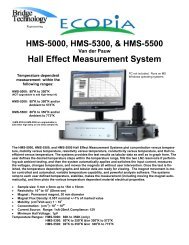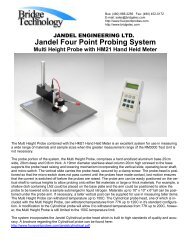Volume and Surface Resistivity - Keithley Instruments
Volume and Surface Resistivity - Keithley Instruments
Volume and Surface Resistivity - Keithley Instruments
- No tags were found...
Create successful ePaper yourself
Turn your PDF publications into a flip-book with our unique Google optimized e-Paper software.
Number 314Application NoteSeries<strong>Volume</strong> <strong>and</strong> <strong>Surface</strong> <strong>Resistivity</strong> Measurementsof Insulating Materials Using the Model 6517AElectrometer/High Resistance MeterIntroductionA fundamental property of insulators is resistivity. Theresistivity may be used to determine the dielectric breakdown,dissipation factor, moisture content, mechanical continuity <strong>and</strong>other important properties of a material. The volume resistivityof some insulators, such as sapphire <strong>and</strong> Teflon ® , can be as highas 10 16 to 10 18 ohm-cm. Because of such large magnitudes,measuring the resistivity of insulators can be difficult unlessproper test methods <strong>and</strong> instrumentation are used. One testmethod often used for measuring resistivity of insulators isASTM D-257, “DC Resistance or Conductance of InsulatingMaterials.” <strong>Instruments</strong> called electrometers are used to make thismeasurement because of their ability to measure small currents.Methods <strong>and</strong> TechniquesThe resistivity of an insulator is measured by sourcing aknown voltage, measuring the resulting current, <strong>and</strong> calculatingthe resistance using Ohm’s Law. From the resistance measurement,the resistivity is determined based on the physical dimensionsof the test sample.The resistivity is dependent on several factors. First, it is afunction of the applied voltage. Sometimes the voltage may bevaried intentionally to determine an insulator’s voltage dependence.The resistivity also varies as a function of the length ofelectrification time. The longer the voltage is applied, the higherthe resistivity because the material continues to charge exponentially.Environmental factors also affect an insulator’s resistivity.In general, the higher the humidity, the lower the resistivity. Tomake accurate comparisons to a specific test, the applied voltage,electrification time, <strong>and</strong> environmental conditions should be keptconstant from one test to the next. According to the ASTMst<strong>and</strong>ard, a commonly used test condition is a voltage of 500Vapplied for 60 seconds.Depending upon the application, the volume or the surfaceresistivity, or both, is measured.<strong>Surface</strong> <strong>Resistivity</strong><strong>Surface</strong> resistivity is defined as the electrical resistance ofthe surface of an insulator material. It is measured fromelectrode to electrode along the surface of the insulator sample.Since the surface length is fixed, the measurement is independentof the physical dimensions (i.e., thickness <strong>and</strong> diameter) of theinsulator sample.TopElectrodeRingElectrodeHILOSampleGuardedElectrode6517AV-SourceGuardFigure 1. <strong>Surface</strong> resisitivity measurement techniqueAHILO6517APicoammeter<strong>Surface</strong> resistivity is measured by applying a voltagepotential across the surface of the insulator sample <strong>and</strong> measuringthe resultant current as shown in Figure 1. The Model 6517Aautomatically performs the following calculation <strong>and</strong> displays thesurface resistivity reading:ρ S= K SRρ S= surface resistivity (per square)R = measured resistance in ohms (V/I)K S= P/gwhere:P = the effective perimeter of the guarded electrode (mm)g = distance between the guarded electrode <strong>and</strong> the ring electrode(mm). Refer to Figure 2 to determine dimension g.For circular electrodes:P = πD 0D 0= D 1+ g (refer to Figure 2 to determine dimension D 0).<strong>Volume</strong> <strong>Resistivity</strong><strong>Volume</strong> resistivity is defined as the electrical resistancethrough a cube of insulating material. When expressed in ohmcentimeters,it would be the electrical resistance through a onecentimetercube of insulating material. If expressed in ohminches,it would be the electrical resistance through a one-inchcube of insulating material.
St<strong>and</strong>ard Method <strong>Resistivity</strong> Tests(<strong>Surface</strong> <strong>and</strong> <strong>Volume</strong>)This test is used to measure the resistivity (surface orvolume) of an insulator sample. When used with the Model 8009<strong>Resistivity</strong> Test Fixture, the test conforms to the ASTM D-257st<strong>and</strong>ard. Figures 1 <strong>and</strong> 3 show the test circuits for the respectivemeasurements, <strong>and</strong> Figure 4 shows the connections to the Model8009. Refer to the instruction manual for the Model 8009 toinstall the insulator sample in the test fixture.When this test is run, the V-Source will initially be set tosource 0V for a specified time (PRE-DISCH time) to allow anycharge to dissipate. The V-Source will then apply a specifiedvoltage (BIAS V) to the electrodes of the test fixture for aspecified time (BIAS-TIME). This “bias” period allows currentsin the test circuit to stabilize. The V-Source then applies the testvoltage (MEAS-V) <strong>and</strong>, after a specified delay (MEAS-TIME),the Model 6517A measures the resistivity of the sample <strong>and</strong>stores the reading in the buffer. Note that the test voltage (MEAS-V) is typically at the same level as the bias voltage (BIAS-V).The <strong>Surface</strong> <strong>Resistivity</strong> Test <strong>and</strong> the <strong>Volume</strong> <strong>Resistivity</strong>Test are selected <strong>and</strong> configured from the CONFIGURESEQUENCE menu (R/RESISTIVITY; NORMAL; SURFACE<strong>and</strong> VOLUME).Alternating Polarity Resistance/<strong>Resistivity</strong> TestThe Alternating Polarity Resistance/<strong>Resistivity</strong> test isdesigned to improve high resistance/resistivity measurements.These measurements are prone to large errors due to backgroundcurrents. By using an alternating stimulus voltage, it is possible toeliminate the effects of these background currents. This test willmeasure surface or volume resistivity or resistance, as selected inthe CONFIGURE RESISTANCE menu. Figures 1 <strong>and</strong> 3 showthe test circuits for the respective measurements, <strong>and</strong> Figure 4shows the connections to the Model 8009. Refer to the Model8009 Instruction Manual for information on installing the samplein the test fixture.When this test is run, the V-Source will alternate betweentwo voltages (V-OFS + V-ALT) <strong>and</strong> (V-OFS - V-ALT) at timedintervals (MEAS-TIME). Current measurements are taken at theend of each of these alternations <strong>and</strong> after calculation of I calcresistance values are computed. I calcis a weighted average of thelatest four current measurements, each at the end of a separatealternation. The resistance value is then converted to a resistivityvalue if the meter has been configured for resistivity measurements.The first few readings can be rejected (DISCARD XXXRDGS) as the sample or resistance achieves a steady-stateresponse to the alternating voltage. After this, the alternation willcontinue until a specified number of readings (STORE XXXRDGS) have been stored in the buffer. The time required tocomplete a sequence is (STORE + DISCARD + 4) × MEAS-TIME. For example, a sequence alternating at 15 second intervals,discarding three readings, <strong>and</strong> storing three readings willtake 2.5 minutes.Figure 5 shows an example of the Alternating Polarity testusing the test parameters shown <strong>and</strong> the resulting sample currentfrom a typical high resistance sample. Note that the samplecurrents shown exhibit some capacitive delay, as many highresistance samples also tend to have significant capacitance.6517-ILC-3 Interlock CableModel 8009WARNING:NO INTERNAL OPERATOR SERVICABLE PARTS,SERVICE BY QUALIFIED PERSONNEL ONLY.LOHIMETERSOURCELID !INTERLOCK!INPUT250V PEAKPREAMP OUT250V PEAKCOMMONV SOURCELINE RATING90-134VAC180-250VAC50, 60, 400HZ55VA MAXLINE FUSESLOWBLOW1/2A, 250VIEEE-488(CHANGE IEEE ADDRESSWITH FRONT PANEL MENU)TRIAX250 MAXHI-LOMAX INPUT1100V!INTERLOCKOUT7078-TRX-3 Triax CableCAUTION:FOR CONTINUED PROTECTION AGAINST FIRE HAZARD,REPLACE FUSE WITH SAME TYPE AND RATING.Model 6517A8607 Banana Plug CablesWarning: Connect of fixtureto safety earth ground usingsafety ground wire (suppliedwith 8002A test fixture).Figure 4. Connections for measurements using Model 8009 Test Fixture
RingElectrodeGuardedElectrodegD 1 D 0 D 2SampleTopElectrodeRingElectrodeD 2D 0HI6517AV-SourceLOGuardedElectrodeGuardAHILO6517APicoammeterD 1gg = D 1 – D 22SampleFigure 2. Circular electrode dimensionsGuardedElectrodeD 0 = D 1 + gTest FixtureDimensions (cm)Model 8009D 1 2.000 inD 0 2.125 inD 2 2.250 ing 0.125 inRingElectrode<strong>Volume</strong> resistivity is measured by applying a voltagepotential across opposite sides of the insulator sample <strong>and</strong>measuring the resultant current through the sample as shown inFigure 3. The Model 6517A automatically performs the followingcalculation <strong>and</strong> displays the volume resistivity reading:Kρ VV= ___ Rτρ V= volume resistivityK V= the effective area of the guarded electrode for the particularelectrode arrangement employedτ = average thickness of the sample (mm)R = measured resistance in ohms (V/I)For circular electrodes:K V = π D 21 g(+ B2 2 )= outside diameter of guarded electrodeD 1gB= distance between the guarded electrode <strong>and</strong> the ringelectrode= effective area coefficientFigure 3. <strong>Volume</strong> resistivity measurement techniqueNotes:1. Refer to Figure 2 to determine dimensions D 1<strong>and</strong> g.2. An effective area of coefficient (B) of 0 is typically used forvolume resistivity.InstrumentationAs discussed, these measurements are made using anelectrometer or picoammeter, voltage source, <strong>and</strong> a resistivitychamber, as shown in Figure 1. The <strong>Keithley</strong> Model 8009<strong>Resistivity</strong> Chamber contains an electrode configuration like theone shown in Figure 2. In the chamber the electrodes arelocated in a shielded box to minimize stray electrostatic pick-up,which can cause measurement errors. The electrodes are made ofstainless steel <strong>and</strong> are built to ASTM st<strong>and</strong>ards.If the sample is made out of rigid material, such as glass,epoxy or ceramics, <strong>and</strong> the electrodes are also rigid, conductiverubber may be needed to make a better contact between theelectrodes <strong>and</strong> the surface of the material. The electrodes in the8009 <strong>Resistivity</strong> Chamber are already covered with conductiverubber. The recommended sample size for these fixtures is threeto four inches in diameter. The ASTM procedure also describesseveral other electrode configurations, depending on the size <strong>and</strong>shape of the specimen.The ammeter is connected to the resistivity chamber usinglow noise cabling. Most of the cables <strong>and</strong> adapters needed tomake the measurements are included with the chamber. The6517A includes a built-in voltage source.TestsThe following test sequences are built into the Model6517A for use with the Model 8009:
When the Alternating Polarity sequence is first armed bypressing SEQuence <strong>and</strong> then ENTER, the settings for thecurrent measurements made internally to the sequence arepreset to the settings for the amps function. If the ampsfunction is set to a specific range, the sequence defaults to thatrange. If the amps function is autoranging, the sequence willdefault to autoranging. The range can be changed after thesequence is armed by pressing the ▲, ▼, or Auto keys. TheAlternating Polarity sequence will not autorange past the 2nArange. If the resistance/resistivity to be measured is high <strong>and</strong> amore sensitive range is required, the user must set this rangemanually using the ▲ or ▼ keys. (For the 20pA <strong>and</strong> 200pAranges, use a measure time of at least 15 seconds.)While in the armed condition, the sequence parameters maybe changed (CONFIG-SEQ…), the range may be changed, theoutput result type may be changed (resistance, surface, or volumeresistivity), <strong>and</strong> the resistivity parameters edited. To run thesequence, press TRIG after arming. Pressing EXIT after armingdisarms the sequence, <strong>and</strong> returns the Model 6517A to thefunction in use when it was armed.During execution, the sequence will show “--------” untilthe first reading becomes available <strong>and</strong> is sent to the buffer. Afterthis, the latest calculated value will be displayed. If, at the end ofany alternation the current exceeds the amps range in use, theerror +618 <strong>Resistivity</strong>:I OutOfLimit will occur <strong>and</strong> the sequencewill abort, returning it to the function in use before it was lastarmed. If the Alternating Polarity sequence calculates a current ofzero, “” will be displayed, but the sequence willcontinue. A lower current range should be selected.The Alternating Polarity test is selected <strong>and</strong> configuredfrom the CONFIGURE SEQUENCE menu (APPLICATIONS; R/RESISTIVITY; ALT-POLARITY).Test System SafetyMany electrical test systems or instruments are capable ofmeasuring or sourcing hazardous voltage <strong>and</strong> power levels. It isalso possible, under single fault conditions (e.g., a programmingerror or an instrument failure), to output hazardous levels evenwhen the system indicates no hazard is present.These high voltage <strong>and</strong> power levels make it essential toprotect operators from any of these hazards at all times. Protectionmethods include:• Design test fixtures to prevent operator contact with anyhazardous circuit.• Make sure the device under test is fully enclosed toprotect the operator from any flying debris.• Double insulate all electrical connections that an operatorcould touch. Double insulation ensures the operator isstill protected, even if one insulation layer fails.• Use high reliability, fail-safe interlock switches todisconnect power sources when a test fixture cover isopened.• Where possible, use automated h<strong>and</strong>lers so operators donot require access to the inside of the test fixture or havea need to open guards.• Provide proper training to all users of the system so theyunderst<strong>and</strong> all potential hazards <strong>and</strong> know how to protectthemselves from injury.It is the responsibility of the test system designers, integrators,<strong>and</strong> installers to make sure operator <strong>and</strong> maintenancepersonnel protection is in place <strong>and</strong> effective.15105CurrentpA0–5–10I calcImeasBackgroundVoltage–15+50VFigure 5.–50V–200 30 60 90 120Specifications are subject to change without notice.All <strong>Keithley</strong> trademarks <strong>and</strong> trade names are the property of <strong>Keithley</strong> <strong>Instruments</strong>, Inc.All other trademarks <strong>and</strong> trade names are the property of their respective companies.<strong>Keithley</strong> <strong>Instruments</strong>, Inc. • 28775 Aurora Road • Clevel<strong>and</strong>, Ohio 44139 • 440-248-0400 • Fax: 440-248-61681-888-KEITHLEY (534-8453) www.keithley.com© Copyright 2001 <strong>Keithley</strong> <strong>Instruments</strong>, Inc. No. 1680Printed in the U.S.A.8012KDCI
















